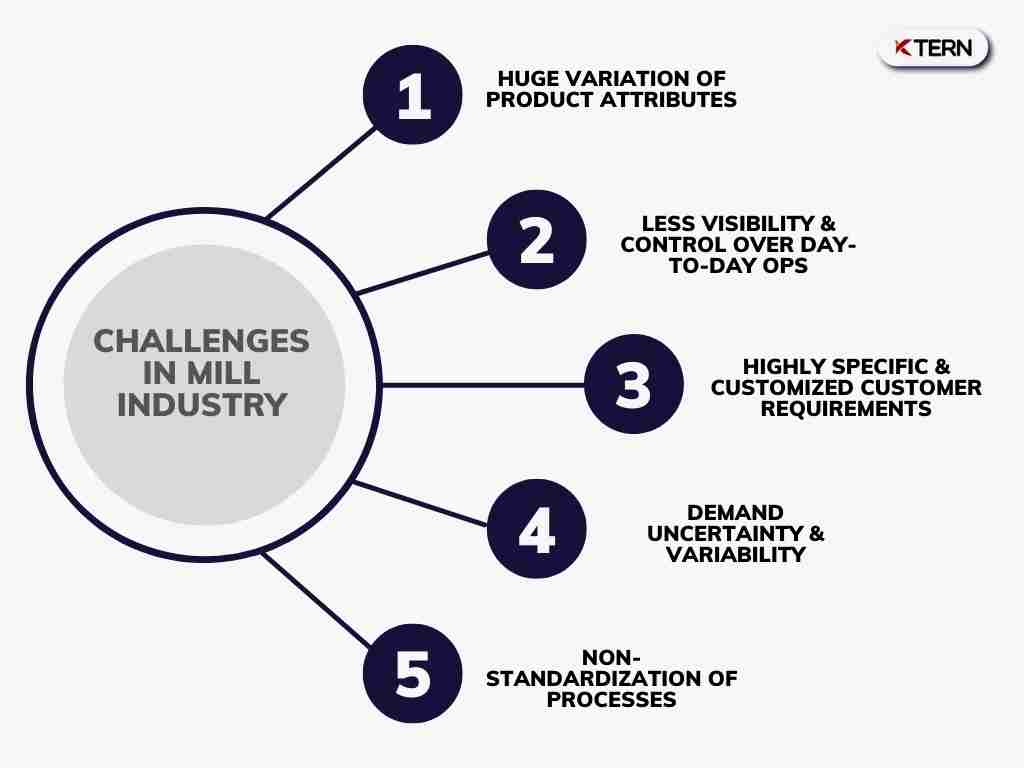SAP S/4HANA IS Mill Solutions: Challenges, Benefits and Next Steps
SAP S/4HANA IS Mill solution provides comprehensive and flexible functionality that caters to the needs of mill product companies. Until now, IS Mill solution was an add-on that had to be activated separately. With the advent of SAP S/4HANA, the solution is readily integrated into the product and is offered as standard functionality.
Business Challenges in the Mill Industry
- Huge variation of product attributes leading to complex SKU management
- Less visibility & control over day-to-day Mill operations
- Highly specific & customized customer requirements
- Rising operating and material costs along with reducing margins
- Demand uncertainty & variability
- Non-standardization of processes across global locations

S/4HANA IS Mill solution adds sector-specific functionality to satisfy the complex requirements of mill industries such as Metal, Wood, Paper, Textiles, Construction materials, and Cable sectors. To cater to the specific requirements of these industry segments, S/4HANA IS Mill solution features processes and functions that cover the entire supply chain cycle.
This article's goal is to describe the current SAP IS Mill solution processes and go into detail about the enhancements and advantages that result from using SAP S/4HANA IS Mill solution. Functionalities like class and characteristic with variant configuration, mill order combination, mill cut process, original batch concept, fast data entry, etc. are provided by the S/4HANA IS Mill solution and are covered in more detail in the sections that follow.
Why SAP S/4HANA?
The next-generation business suite, SAP S/4HANA, was created to make operating in the digital economy simple. It is a new generation of real-time ERP solution that incorporates mobile and predictive analytics. It is possible to deploy SAP S/4HANA in the cloud or on-premises, and it is designed to provide immediate value across lines of business and industries.
Why S/4HANA IS Mill Solution?
S/4HANA IS Mill solution provides an opportunity for mill product companies to achieve greater customer satisfaction through streamlined supply chain management, flexible delivery options and greater control over asset utilization and maintenance.
Considering the complexities involved in mill product industries, SAP introduced S/4HANA IS Mill solution to
- Automate processes from purchase to delivery.
- Streamline manufacturing and maintenance
- Simplify and enhance customer experience
- Streamline sourcing
- Enable faster decision making by providing
- Real time information access
SAP S/4HANA Key Benefits for Mill Product Industries
DIMP as a standard solution
DIMP is the abbreviation for the SAP Mill Industry Solution for Discrete Industries (Discrete Industry Mill Products). DIMP wasn't a standard feature; it was an add-on. By making DIMP a standard feature, the S/4HANA IS Mill solution adds value to the already-existing functionality.
Material Master Data - Volume Reduction
Adoption of characteristics and class functionality enables users to address each and every material master attribute with appropriate combinations, significantly reducing the amount of material master data.
Production Planning and ATP
S/4HANA Making Production Planning, GATP (Global Available-to-Promise), and Manufacturing Planning functionality part of the standard product decreased the reliance on APO. It's possible that in the near future, the other APO features could also become requirements.
Performance Improvements in MRP
Significant speed improvements are included with the new S/4HANA material requirements planning (MRP). An improved customer experience is provided by the speed improvements in addition to the new smart business cockpits. MRP can be used by a user whenever a need arises.
Mill order combination
A typical production process supported by standard SAP is one in which a single production order results in a single output. The SAP IS Mill solution supports a single production process that enables the production of multiple outputs to satisfy various MTO and MTS requirements. Mill order combination, a feature of IS Mill, allows for the combined order execution of multiple outputs.
Industry Solutions with S/4HANA IS Mill
S/4HANA IS Mill provides specific solutions catering to the needs and challenges of the mill industries. It is imperative and useful for an organization to understand these features before implementing an IS Mill solution. A detailed analysis of these solutions and their associated benefits are discussed further.
Class and Characteristics
Related Business Challenges in Milling Industry
- The volume of the material master data is increased by the numerous characteristics and variants of the materials used in mill industries.
- Production planning is challenging because the materials in the aforementioned market segments are primarily area-based (e.g., paper, textiles, plastic film) and length-based (e.g., cables, piping) in nature.
Solution in SAP S/4HANA IS Mill
- Materials with the same type of characteristics but different characteristic values are grouped together.
- A configurable material represents all the materials in a group and is assigned to a variant class and batch class.
- These classes contain all the characteristics required to describe the materials in a given group.
Combined Production Order Processing
Related Business Challenges in Milling Industry
- To maximise utilisation and reduce waste, multiple customer orders and stock orders must be combined (processes like slitting, cut to length, etc.).
- Cost allocation should be based on input product utilisation on a fair share basis.
Solution in SAP S/4HANA IS Mill
One production order may be created by combining common operation sequences from various orders; this combination may be for a single operation or the entirety of an order. The operations to be combined should use the same base unit of measurement.
There are three steps: selection, combination, and scheduling.
- Combined order costing bases its calculations on the use of input products.
Fast Data Entry in Production Order, Purchase Order, and Sales Order
Related Business Challenges in Milling Industry
Along the supply chain, characteristics must be entered quickly and easily. Additionally, a material to be manufactured may share characteristics with the material from which it is made.
Solution in SAP S/4HANA IS Mill
- Under item overview, characteristics and item data can be entered on a single line. By doing so, switching between multiple screens is no longer necessary.
- Characteristic transmission from input components to output items (output)
Mill Cut Process
Related Business Challenges in Milling Industry
Inheritance of batch characteristics is necessary following the splitting of material into output batches
- Single batch (such as a Jumbo coil) needs to be split or sliced into many batches
- These do not require extensive production order management and cost allocation requirements
Solution in SAP S/4HANA IS Mill
In a mill cut operation, it is possible to:
- Divide a single batch into numerous batches;
- Post input and output batches in a single phase;
- Batch characteristic inheritance
Scrap accounting to cost center/scrap materials/inventory differential enables quantity balance.
Original Batch
Related Business Challenges in Milling Industry
When receiving items, characteristics entering must be made simpler, and batches of the same origin require central batch status control.
Solution in SAP S/4HANA IS Mill
Original batch characteristics are defaulted during goods receipt. Original batch status changes result in status changes for linked stock-keeping batches. Original batch inheritance through production levels is conceivable. Original batch master records can be generated.
- The "batch where usage list" and "Batch information cockpit" both have the option to display an initial batch.
Batch Information Cockpit
Related Business Challenges in Milling Industry
- Need one T code for complete information of stock batches
Solution in SAP S/4HANA IS Mill
Batch information cockpit offers batch selection criteria such as materials, categorization data, stock data, and self-expiration date.
The following display options are available:
- Display Alternative UOM
- BADI for display object with reference to batches - inspection lot, deliveries, Handling Unit, and storage bins
Purchase Information Record
Related Business Challenges in Milling Industry
Materials must be obtained with specified characteristics (such as numerous dimensions, packing, and quality), and vendor orders frequently have the same characteristics.
Solution in SAP S/4HANA IS Mill
In purchase information records, specify attributes for each type of seller and material. You can transfer characteristic values from a record of purchasing information to a product on a purchase order or requisition.
Single Unit Batch
Related Business Challenges in Milling Industry
All business processes regard individual material management (Jumbo/Coils) as one unit. Materials are managed in batches, with one unit per batch, such as KG/ROLL.
Solution in SAP S/4HANA IS Mill
Batch specific UOM allows for the specification of batches as a single unit that is governed by the material master definition.
- Batch characteristics include details regarding the worth of a single piece.
- During goods movement, material batches may be moved as a single unit.
Purchase Information Record
Related Business Challenges in Milling Industry
A material must be obtained with certain characteristics (such as numerous dimensions, packing, and quality), and vendor material orders frequently have the same characteristics.
Solution in SAP S/4HANA IS Mill
In purchase information records, specify attributes for each type of seller and material. You can add characteristics from records of purchasing information to items on purchase orders and requisitions.
Single Unit Batch
Related Business Challenges in Milling Industry
All business processes regard individual material management (Jumbo/Coils) as one unit. Materials are managed in batches, with one unit per batch, such as KG/ROLL.
Solution in SAP S/4HANA IS Mill
Batch specific UOM allows for the specification of batches as a single unit that is governed by the material master definition.
- Batch characteristics include details regarding the worth of a single piece.
- During goods movement, material batches may be moved as a single unit.
Sales Order Amendment
Related Business Challenges in Milling Industry
Due to demand changes, client specifications for dimensional products frequently change multiple times before final delivery. Production staff must review the proposed revisions before receiving final approval from the customer.
Solution in SAP S/4HANA IS Mill
The IS Mill solution offers the option to send the planner change version of the sales order. The planner change version can be used to make configuration changes, and the saved version can be sent to the production worker via workflow. The production worker can then check to see if the changes were made and the data in the original sales order was updated.
Customer Information Records
Related Business Challenges in Milling Industry
- The client routinely orders materials with comparable properties.
Solution in SAP S/4HANA IS Mill
Reduces the amount of data entry and reduces the possibility of errors by transferring characteristic values from the customer-material information record to the configuration of a sales document item.
Non-Ferrous (NF) Metals Pricing
Related Business Challenges in Milling Industry
- Non-ferrous metals are often traded on metal exchanges around the globe, where prices change every day. It is vital to ascertain how price volatility affects the end product's cost.
Solution in SAP S/4HANA IS Mill
The condition approach is supported by IS Mill Non Ferrous Pricing to support different rate determinations for NF metals sold on stock and metal exchanges. The NF metal key identifies a particular NF metal, and the base quantity is assigned to a certain NF metal key.
NF metal rate may be sustained at various
- Levels for varying lengths of time.
- Modules, procedures, and keys are used in rate determination. Pricing for document goods is started as part of the NF metal price determination procedure.
Conclusion
Organizations may combine commercial, manufacturing, and financial processes with the SAP S/4HANA IS Mill solution to gain more insight into operations, production, and clients. Additionally, it takes into account functions that are industry-specific, such as combined orders, mill cut process, original batch, rapid data entry, etc., that lead to process improvements with less work and expense.
The IS Mill solution, which accounts for more than 50% of all IS solutions deployed globally, has the largest installed base out of the 20+ industry solutions that SAP provides.
Higher client adoption rates serve as evidence of the enormous advantages an IS Mill solution can provide. The availability of IS Mill solutions as a basic feature of S/4HANA creates the opportunity for much wider adoption across different mill industries.
Transforming an SAP S/4HANA is not easy and it requires careful and understanding. Get standard by knowing how SAP S/4HANA IS Mill will help your current setup and how it can impact your overall transformation journey.your




